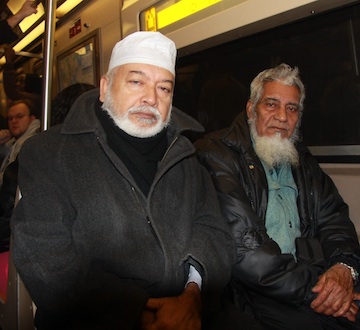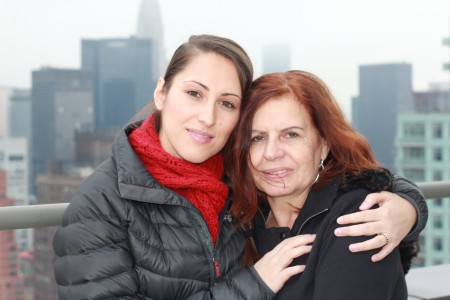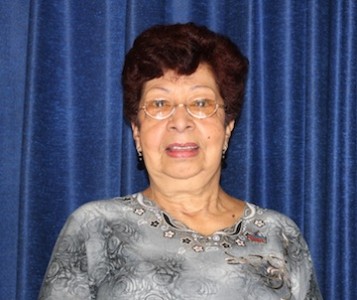The American Dream is Getting Old by Faith E. Briggs
by Faith E. Briggs
People who have worked their whole lives contributing to this economy may find that the American Dream doesn’t include support for them in their older age.
Esmeralda Castro is all smiles as she walks gracefully through the Casa Boricua Senior Center in the Bronx. On all sides, small tables are packed with seasoned domino players. She’s lived within a twenty-block radius of the center since she first came to the Bronx in 1959 at age 19, following her sisters’ example. “In Puerto Rico everybody loves New York, without visiting it,” she says. “Because you hear and you see on TV. I said, ‘I want to go to New York, it’s so pretty.’” When she easily found a job as a day laborer in a zipper factory, she tied up loose ends in Puerto Rico and came back to stay. “At home I was making by that time $38 a month. I came here and I made the same amount in a week!”
Castro is now 73 years old, she spent her years working in clothing factories and stores until her last employer, Alexander’s Department Store, closed in 1992 and she retired. She now lives happily with the help of her social security and salsa Fridays at Casa Boricua.
With other seniors from Casa Boricua she recently reflected on her life though a musical production entitled “Ayer y Hoy.” A new initiative from the Department of Cultural Affairs brought a young dancer who wanted to pay homage to her grandmother’s legacy to work at the center, Milteri Tucker. Growing up as a little girl in Puerto Rico she remembers her late grandmother telling of her time living in New York saying, “I came in search of the American dream, the great American dream.”
Tucker says the reasons for coming to the US were the same among her “ladies,” as she fondly calls the women, including Castro, who learned the dance form bombazo with her at the center. “The general consensus is to find a better job and a better way of living, higher education,” she says.
In New York City specifically, foreign-born workers make up 43 percent of the working population. In many occupations they make up a majority of the labor force. Personal services, such as nails salons and dry cleaning, are comprised 68 percent of foreign-born workers. Similarly, 56 percent of repair services and community organizations, 56 percent of construction, and 55 percent of leisure and hospitality (including restaurant work) are made up of foreign-born workers, according to a 2010 report from the office of the New York State Comptroller.
The report concludes: “Immigrant workers helped build the City and its infrastructure, filled many of the jobs that kept it running, and created businesses that grew into major corporations.” These workers are now getting older as they do, the current landscape does not include pathways to secure retirement.

Men unloading fruit and vegetables on Fulton Street in Brooklyn, NY.
Research by the Assistant Secretary for Planning and Evaluation (ASPE), an advisor to the U.S. Department of Health and Human Services, looks specifically at policy trends that provide access to health and human services. Welfare Reform initiatives such as The 1996 Personal Responsibility and Work Opportunity Reconciliation Act (PRWORA) signify one attempt to assure that people can get the government help that they deserve, without unnecessary dependence on welfare and with an emphasis on employment. Immigrant groups were specifically targeted through the creation of financial assistance in the form of Temporary Assistance for Needy Families (TANF). However, the ASPE recognizes several barriers that block immigrant workers from accessing services legally available to them including lack of knowledge about the programs, confusion about the eligibility requirements, language and cultural sensitivity issues, and fear of adverse immigration consequences.
At The New York Immigrant Coalition, Thanu Yakupitiyage agrees, adding anti-immigration policies as a contribution to low-income among immigrant populations. “It’s a huge issue that hinders access to particular kinds of employment. And there is a lot of fear, so they end up in low wage jobs and employers can exploit them because of [undocumented] status, so they can’t fight for their rights,” she explains. Faced with these issues throughout their working lives, aging people from immigrant groups find themselves unable to make ends meet. However, the barriers to a secure retirement don’t stop at policy issues, they are very often also include cultural differences.
“I was afraid of the American people,” explains Castro, “Because in Puerto Rico they did teach you English by that time, but a different English. And then when I got here and I saw an American and they talked I was afraid.” For this reason, Castro chose to work, live, and socialize among other Latino immigrants throughout her working life.
Fear, confusion, and difficulty adjusting to cultural issues faced in New York City leave many immigrants with added predicaments. “They are trying to establish themselves based on what they know and what they’ve learned, that’s a very different trajectory from people who have family here,” says researcher and professor at the Brandeis University Heller School for Social Policy and Management, Tatjana Meschede. Difficulty in overcoming cultural hurdles varies depending on background and the consequences follow workers into their older years.
Bediako Agyemang came to the US from Ghana in 1990 as a political refugee in the wake of the military coup by the Jerry John Rawlings government. Based on his experiences Agyemang feels the US has been good to him. “In America here, if you want a place to sleep you can get it. This country, I don’t see any country better. There’s a lot of things since I came to this country that I have gotten. If I was home in my country I would not get them as a matter of fact, it’s a good place.”
Agyemang is not alone in his zest for life in the United States or in the fact that it hasn’t come without difficulty. He first arrived in Bed-Stuy Brooklyn as New York City struggled with high crime and drug use. He had no family or friends and found shelter and a job as a taxi-driver with the help of a local church ministry. “When I came here first, it was good, but I messed up myself when I started using drugs,” he explains with a drawn face. “After that things fell apart. I lost my job, I lost my apartment, I ended up in the streets. That’s where I lost my eye, in the streets here. Because of the drugs I went through a lot.”
Today Agyemang can be found sitting in a glass shop in Bed-Stuy, no longer regularly employed. His closely shaved head hides his grey and his glasses slightly obscure one scarred socket. His fifty-five years are hard to discern, his experiences leave him worn and he continues relying on modest means to get by. As he moves towards his older years he has no savings, no social security, and no welfare to help financially. “I went there [welfare services] and they told me it was too late, because they have a time limit. Right now I don’t have any help from anywhere.” His tarnished background makes it difficult to find jobs and support, or even secure a green card.
According to the Center for Immigration Studies’ analysis of data from the American Community Survey on Census Bureau from 2010, for older people, the fraction in poverty is 19 percent for immigrants and 15 percent for natives. In addition, 44 percent of elder immigrants have low income, that number is 33 percent for native-born adults over the age of 60.

Older immigrant New Yorkers adjust to city life and commute daily on New York City subways.
Finances are particularly unstable for Blacks and Latinos, both native and foreign-born. As part of a “Living Longer on Less” series from the Institute on Assets and Social Policy (IASP) at Brandeis, Meschede’s work investigates secure retirement using the Senior Financial Security Index (SFSI). Her conclusions show that more than half of Blacks and 56 percent of Latino seniors are economically insecure, significantly worse than white seniors. Meschede points out that these seniors are more likely to have worked in low-income, often highly manual jobs and now find themselves unable to work late into their lives. “In certain professions you can stay and work longer, in others you can not. That excludes some people from being able to work longer. Even if they want to, they might not be strong enough anymore.”
The history and more subtle persistence of housing and employment discrimination also contribute to the problem. “You have to go back and see when they grew up and when they started working,” Meschede says, “All of that has long-term impact in terms of when you’re retiring and where you’re at [financially].” Based on the issues faced upon arrival she says simply, “We expect immigrants to do much worse in retirement.”
Beyond occupational circumstances, there are further contributing factors to poverty later in life in the form of immigration policy issues, community development, language access and education.
For Aleksandra Zelazewski, like many immigrants, access to a secure job market was always difficult. She spoke no English when she arrived from Poland and remembers how difficult it was to negotiate the city. She was forced to leave behind her life in 1989 with her husband and two small children as political refugees during the widespread Solidarity Movement, which took opposition to ruling Communist governments. Upon arrival she was given $20 and the key to a room in a motel. Eventually they were able to find a decent apartment and move to the Glenwood Projects in Canarsie, which housed forty other Polish families, mostly other political refugees.
She never thought she would leave Poland as travel was not encouraged at that time. “If you don’t know English, even I speak very badly but I understand everything now. That is easy. But if you walk around this city, at the store you go to and its only English and you don’t know anything. That is very hard.” Zelazewski took strides to learn English, she spent one year in ESL classes at Brooklyn College, but the toll of having to bring her youngest daughter to class made it difficult to continue attendance. She says she learned her English in the streets and though she understands the language, still struggles with writing and English phonetics.
Language barriers are one of the largest roadblocks immigrant workers face to higher paying job opportunities. The inability to speak English leads to sustained low levels of education among immigrants long after their arrival and therefore sustained immobility in low paying jobs. The help that is available habitually funnels immigrant workers directly into low-paying jobs where they will stay their whole lives.
Many immigrant families that do into older age, with low ability to advance economically need help, and those who do know their rights rely heavily on social services such as WIC, TANF, and Social Security, according to the Center for Immigration Studies research based on the 2010 census data. Poverty is at an all time high among seniors over the age of 65, irrespective of ethnic background, but rates among historically disenfranchised groups are significantly greater.
Meschede’s research shows that economic security is actually an exception to the norm for Black and Latino seniors. “If the trends continue it means everyone needs to move in with their kids. This impacts their families, everybody is actually impacted by this not just the seniors,” says Meschede. She argues that among Black and Latino seniors we have reached a crisis level. “We no longer have pensions. A lot of people with low skills used to have pensions — that is all gone.” she says. “We all need to become financial planners now.”
She points to declining support systems such a disappearing pensions and wavering or ineffective social security resources as a contributing factor for seniors struggling to attain financial stability. “There used to be minimum benefits put in place to make sure people have at least poverty level income, which many seniors don’t even have,” she said. “That has not kept up with inflation.”
Today medical and housing bills are high, leaving seniors skipping appointments and struggling to pay rent, with nothing left at the end of the month. Seniors who have worked for years in low-income jobs could once rely on these resources to cover their expenses, but social security is no longer enough. “Wages have stagnated,” says Meschede, “Social security payments are based on your payments, 35 years of your life. With low income and middle income wages stagnate for at least twenty thirty years, that is not improving your prospects in retirement.”
Safety from brutal dictatorships, access to educational opportunities, and hopes of economic prosperity continue to bring many immigrants to New York City. Despite living in poverty, most are joyful to experience freedom of expression, the ability to work, some access to resources (more than they would get at home) and don’t regret their lives here.
Zelazewski remembers her early years fondly, “We didn’t have much. We had almost nothing over here too but we were safe.” She continued, “I’m very happy for my kids, for Dagmara, for Marika, they have good families, beautiful houses, and I am so happy with this. You know its like, they help me. In my age in Poland I’m supposed to help my kids.”
Zelazewski has also discovered another way to offset her living: scratch tickets.
“I play all the time,” she says. Her youngest daughter Veronika Dominicyzk says they’ve stopped trying to convince their mom not to play. “How do you justify it for someone who wins all the time. She just went to a casino and won $1000. On housekeeping she makes $150 a house.
She makes tops $300 off of that. She actually supplements her living by winning,” she says.
A recent win will stand in for the retirement plan she never had cleaning houses; in August 2012 she won $100,000 in the lottery. “You know, I knew some day I would win,” she exclaims, “Everyone was mommy stop, don’t scratch, don’t do it. But you know. I win and now I have! Now I don’t need help because I have money!” she says joyfully.
Perhaps extraordinary luck like winning the lottery is the only true answer to achieving the American Dream.
Related Stories:
English Language Learners: Breakthroughs and Barricades

